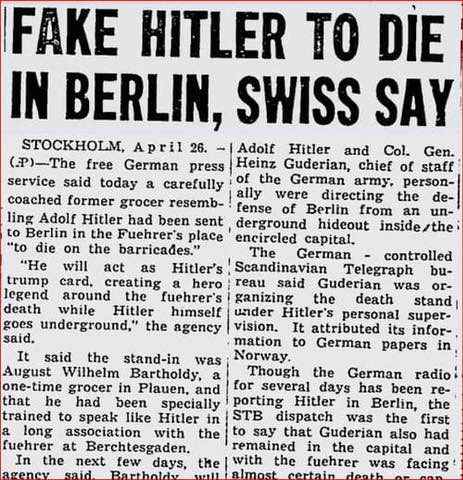April 30th marked 70 years to the day since Adolf Hitler is recorded by history to have met his infamous end; taking his own life in a Berlin bunker as the city lay in ruins around him, the war lost.
The image of a defeated, deflated Hitler confined to his Fuhrer-bunker for the final weeks of the war, declining in health, losing his grip on reality and struggling to comprehend the Nazis’ crushing defeat and the loss of Berlin, is one of those evocative, palpable moments in history that is deeply established in the collective consciousness.
Any book on Hitler’s life you might read, it is invariably these final stages that are the most compulsive, the most compelling.
On 22nd April, Hitler had launched a tirade against the treachery and incompetence of his commanders, culminating in a declaration for the first time that that the war was to be lost; Hitler announced he would stay in Berlin until the very end and would shoot himself.
This was seen as the only suitable end for the man whose immense cult of personality was the gravitational center of the entire German nation and the Second World War.
The idea of Hitler and his young bride, Eva Braun, being hastily married in the bunker (while enemy troops were forcing their way into the city and battles were being fought all around them) and then committing suicide together is so famous and so prevalent a feature in our perception of the war’s end that it can feel counter-intuitive to question it. In the ‘official history’, if there is such a thing, we are told that at around 3.30PM Heinz Linge, who had served as Hitler’s valet for a decade, heard a gunshot and opened the door to the study and found Eva Braun and Hitler sat side by side, both dead. Braun has apparently taken cyanide, while Hitler had shot himself with his Walther pistol.
But was this really the genuine end of Adolf Hitler; or was it simply the official ‘final chapter’ agreed upon to appease all parties and the history books?
History accepts (or insists) that Adolf Hitler, the fascist demagogue and Nazi Messiah who drew Europe and the world into war, committed suicide on April 30th 1945, perceiving that his grand vision for himself, Germany and Europe was over. However, official history would also have everyone believe that JFK was shot three times by a lone fanatic from an impossible angle; in other words, obvious untruths are often accepted as ‘history’ either because the establishment wishes a particular version of events to be set in stone or because even when the reality of a historical event is unclear, *something* still needs to go in ‘the history books’; in the latter case, what we end up with is best described as ‘consensus history’, whereby everyone seems to simply agree on a version of events for the sake of closure.
That sort of ‘agreed history’ is much more difficult to establish in this day and age with all the independent on-line media, social-media and independent research, but in 1945 even television hadn’t established itself yet.

The accounts have always differed as to the specific cause of Hitler’s death; one stating that he died by poison only, with another (Heinze Linge, for example) that he died from a self-inflicted gunshot while biting down on a cyanide capsule. Many contemporary historians reject these accounts as being either Soviet propaganda or a sort of halfway compromise in order to reconcile the niggling differences in the stories.
But it is important to remember that we, looking back from a distance of 70 years and with the established mainstream ‘history’ embedded in our perception, have a very different view to what many people – including better informed people – may have had at the time.
If you examine media coverage and newspaper articles *at the time* in 1945 (and for some time after), news items concerning the possible survival of Adolf Hitler were cropping up all over the world. Virtually every major newspaper, including for example The New York Times, ran stories questioning whether Hitler was really dead or whether he’d in fact escaped the Soviet invasion.
News of Hitler’s activities and whereabouts in general near the end of the war were sketchy at best, contrary to the common hindsight-perception of the situation that has been established in our minds.
There is, to cite just one example, a New York Times piece dated April 26th 1945 and entitled ‘Hitler Imitator Reported Ready to Die in His Place’, which speaks of a former grocer, August Wilhelm Bartholdi, who was a double for Hitler and who was thought to be preparing to die on the Fuhrer’s behalf, allowing Hitler’s end to be faked for posterity.

Highly significant public and political figures are on record as having added fuel to this ‘Hitler Survival’ theory that was already spreading from virtually the moment his death was announced. In 1952, American President Dwight D. Eisenhower admitted, “We have been unable to unearth one bit of tangible evidence of Hitler’s death. Many people believe that Hitler escaped from Berlin.”
When President Harry Truman asked Josef Stalin at the Potsdam conference in 1945 whether or not Hitler was dead, Stalin simply replied bluntly, “No.”
Stalin’s top army officer, Georgi Konstantinovitch Zukhov, whose troops were the ones to occupy Berlin, stated after a thorough investigation in 1945: “We have found no corpse that could be Hitler’s.”
Indeed many in the Soviet Union continued to suspect that Hitler had been allowed to escape by the Western Allies. The subsequent theories of Hitler’s secret survival and escape became so widespread over the years that by the 1990s the likes of The Simpsons could subtly parody it and everyone would get the reference. The absolute best resource, by the way, for information on Hitler’s ‘death’ and possible survival is this website: anyone interested in the subject should visit it.
What we also should understand is that the official narrative of Hitler’s death is actually pretty shaky when we actually scrutinise it; and of course it differs depending on who’s account you’re looking at.
When we strip away the layers and decades of regurgitated ‘facts’ and established perceptions, we find in fact that the entire suicide narrative of Adolf Hitler rests largely on the claims of four Nazis; these were Hitler’s valet Heinz Linge, his adjutant Otto Günsche, his personal pilot Hans Baur, and his Chief of Bodyguards. All of these men, however, were fanatically loyal to their Fuhrer and would’ve been precisely the sorts of people who would be most trusted to help facilitate Hitler’s escape and to help concoct a cover story for a ‘faked death’.
And even these men’s testimony changed over the years, details altering over time.
According to even the official history, the Soviets claimed strangely to have dug up Hitler’s burned body, reburied it, dug it up again, and eventually brought the skull to the Soviet Union. This key piece of the puzzle has since been proven untrue, however: the skull they for so long claimed was Hitler’s has been tested for DNA and it was revealed to be the skull of a woman approximately in her forties.
Meanwhile the only witness to have actually identified Hitler’s body was a Russian diplomat who had previously met the Führer only once. No German witnesses ever saw or identified the remains said to be Hitler’s, but this would not have been due to any shortage of available witnesses. For example, Stalin’s General, Georgi Konstantinovitch Zukhov, had twenty Germans come to identify the remains of Josef Goebels, the Nazi Propaganda Minister, who had committed suicide with his wife and all of their children.
The way Goebels’ death was handled is the example of how such affairs should be – and would be – ordinary handled. When the bodies of Josef and Magda Goebels were discovered, they were put on display and thoroughly photographed from every angle. And yet when it came to the corpse of Adolf Hitler, the absolute leader of the Third Reich and the symbolic figure whose death was the most important, there was only ever one photograph taken; and even this one photograph is riddled with questions. For one thing, whether the face of this figure in the picture is Hitler’s at all has been questioned by numerous people over the years; there’s certainly a resemblance, but in some respects it isn’t decisively enough a match for Hitler for the question to be put to rest.
Regardless of that, however, the question remains of why only one picture was taken and why was it taken from a distance?

Surely they understood how important this was and would’ve taken at least one better shot? The question also lingers as to why no further pictures were taken during any autopsy.
As a point of comparison, there were several decisive photographs taken and released when John F. Kennedy or, more recently Muammar Gaddafi, were killed; aside from the other reasons why such images are necessitated, when it comes to important symbolic figures of this kind there’s the need to demonstrate their death decisively and quash the development of ‘survival myths’. In order to prevent Hitler, who was already such an idolised and powerful symbol, from continuing to be an inspiration or a galvanising influence to his followers, logic would dictate that those with the ability to do so would want to make certain his death was clearly demonstrated.
Yet this isn’t what happened.
Various people have long believed that the dead body in the photo was in fact Hitler’s double; if not August Wilhelm Bartholdi, then possibly a man called Gustav Weler or Weber, who may have been executed with a shot to the forehead in an attempt to confuse the Allied troops during the capture of Berlin. Reports also spread in Russia that an actor, a man allegedly named Andreas Kronstädt, was the impersonator who had volunteered to die in Hitler’s place. In Germany some still point to a Julius Schreck, who was Hitler’s favorite driver and a Nazi party member from 1921. Schreck, it is said, occasionally acted as Hitler’s double because of their coincidental resemblance.
Newsweek had in fact published an article titled ‘Adolf Hitler’s Double’ as early as March 1939, demonstrating how established this idea already was that Hitler had fanatically loyal doppelgangers.
Goebels was actually believed to have engaged at least six doubles to impersonate Hitler, both for the purposes of security and even for some public appearances. So the idea that one of the doppelgangers might have been used to stage the Fuhrer’s death isn’t so far-fetched.
The idea that Hitler had escaped and fled to South America continued to fascinate researchers for decades and it continues to this day, having long since become a primary staple of conspiracy lore. Some of those theories were, even at a relatively early stage, taking on increasingly exotic properties such as secret North Pole bases, the famous “Hollow Earth” stories and so on (one of my favorites for sheer entertainment value is that Hitler was the ‘Magical Child’ of the infamous Black Magician Aleistar Crowley; in essence, a ‘projection’ of Crowley’s psyche).
However, the likeliest idea was simply that he escaped into South America – a feat demonstrably accomplished by both Adolf Eichmann and the “Doctor of Death” Josef Mengele. Various theorists differ in their details, but in the broad strokes tell the same story.
As I touched on briefly in this post, according to writer and investigator Simoni Renee Guerreiro Dias, author of Hitler in Brazil – His Life and His Death, the architect of the Third Reich lived in the small town of Nossa Senhora do Livramento in the state of Mato Grosso in Brazil, having initially fled Germany to Paraguay. A Brazilian Jew, Simoni claims to have come across the proof of Hitler’s presence in the town while hunting for buried treasure in the area using maps given to him by The Vatican.
According to this version of the story, the Fuhrer assumed the name “Adolf Leipzig”; the intriguing figure in the photograph below is claimed to be Adolf “Leipzig” posing with his girlfriend, a local woman named ‘Cutinga’, two years before his natural death from old age in 1984 – which would be some forty years after the end of World War II and Hitler’s ‘official’ date of death.

The enduring tales have it that Hitler lived comfortably in this town for many years (reaching the age of 95) and was known to locals simply as “the Old German”.
In their book, Grey Wolf: The Escape Of Adolf Hitler, the British authors Gerrard Williams and Simon Dunstan argue that the Führer escaped exactly as the stories have always suggested, with his final destination being Argentina (although, for the record, Argentine journalist Abel Basti insists the authors stole his research, so the credit may be his).
The authors tell us; ‘Everything had been prepared to the last detail by the shady head of the Gestapo, Heinrich Müller, right down to the clothes worn by the body doubles that would pass for the corpses of Hitler and his bride, Eva Braun. Had any German citizen spotted them, he or she would have been astonished to see the Führer scuttling away like the cowards he so despised. Accompanying him were Eva Braun and her brother-in-law, Hermann Fegelein. Dodging fires and explosions, the small party made its way to the vast Hohenzollerndamm that ran through the center of Berlin. Once a fashionable boulevard, it was now a makeshift runway, and on it sat a Junkers-52 transport aircraft, its engines being gunned by an experienced Luftwaffe pilot. Within a minute, the plane soared into the air, heading north. The Führer refused to look out of the window, unwilling to face the hell he had left behind. He was heading to a new life and a new world.’
That life, as it would be for so many other Nazis, would be – according to this theory – in Argentina. After landing in Denmark, the claim is that he flew to Spain, where General Franco supplied him with an aircraft to take him to the Canary Islands. From there, the Führer took a submarine to the Argentine coast, where he disembarked near the small port of Necochea, some 300 miles south of Buenos Aires.
They conclude that after 17 years in hiding, ‘one of the most evil men in history’ died on February 13th 1962, aged 73.
Again, the fact that Eichmann and Mengele certainly did escape Germany to South America has certainly helped add weight to the Hitler lore over the decades. Although one curious, possible counter-argument to the theory would be the fact that the various, famous ‘Nazi Hunters’ and Israeli intelligence missions that were so famous for the first few decades after the war had never, as far as we know, been ‘on the hunt’ for Adolf Hitler in the way they were for Eichmann and others; which might suggest they never believed he was still alive.
Because surely if Hitler was thought to have still been at large, his capture would’ve been the first priority. However, the entire subject area of Nazi officials escaping and living out their lives in Argentina or other South-American countries (both those known to have done so and those merely theorised) has become a substantial mythology in itself, albeit one with basis in facts. This recent discovery of an alleged ‘Nazi Hideout’ deep in the Argentine jungle simply reinforces this mythology by reminding us it has a strong basis in reality.

It is a well-known fact of history too that numerous Nazi scientists, including the famous Werner Von Braun, were spirited off to safety and long lives in America to assist American science and engineering in their Cold War contest against the Soviet Union (the American/Nazi collaboration officially referred to as ‘Operation Paperclip’). Indeed, Von Braun was deeply involved in getting the United States to the Moon.
While no one that I know of has ever credibly suggested that Hitler himself would’ve been deliberately kept alive by Allied Forces, all of this does illustrate the point that there were various ways various Nazis escaped the end of the war.
There is also a serious case to be made that neither the US nor the other Allies would’ve had any appetite to put Hitler on trial for War Crimes; one key reason for this would’ve been because one of Hitler’s most pertinent ‘defenses’ would have been to remind everyone that he had offered to ‘trade Jews for trucks’, and moreover that he had sent almost a thousand Jews to America on the liner St. Louis, but that the US had turned the ship back to Europe and Germany, where about a quarter of the passengers subsequently died in the Holocaust.
This was a serious issue; Jews sent in large numbers away from Germany had in fact been turned back from several other countries too and left to their horrific fate (this had included the UK and Australia). I touched upon that point in this recent post about the Holocaust; that in all the commemoration of the Holocaust victims, the mainstream narrative likes to forget how many Jews were refused asylum into the lands of the ‘Good Guys’ and were sent back to be exterminated (perhaps something that the Katie Hopkins‘ and the other immigrant-haters of today should bear in mind).
Hitler not facing the Nuremberg Trials is of course one of the big curiosities of history; every historian must wonder what that scenario would have played out like… and would it have been in the interests of anyone involved?
Goering of course did stand trial and even members of the prosecution were on record as having admitted he’d been very entertaining and charismatic and one or two of them even developed a soft-spot for him just purely due to his physical presence.
These sorts of things can sometimes muddy the waters of perception; Saddam Hussein got one last platform during his trial in Iraq in 2005 and some people still regard that as one of the ‘greatest speeches ever in a court’. What would Hitler’s trial have been like? And did anyone really want such a thing to happen? It probably wasn’t in anyone’s interests; and therefore if there was a plot for Hitler to fake his death and make an escape, it’s possible that even if the Americans, British and Russians had known about it, they might’ve simply let it happen and run with the ‘suicide’ story for convenience’s sake.
When Nazi Germany was brought to ruin, Hitler had to be seen to ‘die’ as it was the only honorable, fitting end for a figure whose myth was far more powerful than the man himself (and it was what he had vowed he would do); for someone like Hitler to remain in the post-Nazi Germany would’ve been neither in the interests of Germany’s enemies nor of Nazi loyalists who’d have to see him degraded by the process of legal proceedings (and most likely execution).
Of course, that could still simply mean that he did kill himself in that bunker 70 years ago this day; that he simply fulfilled the vow he’d made to depart in that fashion. And most analyses of Hitler’s psychology, though not fool-proof of course, indicate that Hitler was far likelier to have chosen to die at the war’s bitter end and gone down with his Third Reich than to have sought to live on beyond the absolute failure and collapse of his vast, costly scheme.
His psychology, it would be argued, didn’t have any room for defeat or compromise; to live on would’ve been humiliation. Unlike say, Eichmann or Mengele, he wasn’t simply a senior Nazi figure: he was Nazi Germany. He was the ideologue, the cult of personality, around which everything revolved.
When the ‘dream’ died so spectacularly, could Hitler really have any desire left to live?
Recently, long lost archive recordings emerged featuring testimony from several witnesses who’d been in and around the bunker in 1945. A Colonel Holsten, who was allegedly in the bunker when Hitler and Braun ended their lives, recalled how he saw the bodies being dragged up the narrow stairs to the Reich Chancellery garden where they were doused in petrol and set aflame. He automatically raised his arm “one last time in the ‘Hitler Greeting’ to salute him.” Hermann Karnau, an SS bodyguard said; “I tried to get back through into the bunker through the emergency exit when I saw about 20 metres away from me the bodies of Adolf Hitler and Eva Braun. They had been set on fire. I recognised that it was Hitler from his uniform and his distinctive mustache. I had seen the Fuehrer alive that morning sitting in his favourite wicker chair. Later in the day, before the suicides, I recalled seeing four men arrive with gasoline cans…”
It is known that during the course of 29th April, Hitler had learned of the death of his fascist ally, Benito Mussolini, who had been executed by Italian partisans. Mussolini’s body and that of his mistress, Clara Petacci, had been strung up by their heels. The bodies were later cut down and thrown in the gutter, where resentful Italian citizens reviled them. It is probable that these events strengthened Hitler’s resolve not to allow himself or his soon-to-be wife to be made a public spectacle of in that same fashion.
Swansong 1945: A Collective Diary of the Last Days of the Third Reich is a volume from the World War II series Echolof by the German writer Walter Kempowski. It combines letters, diary entries, memorandums, and reports by participants and witness from WWII to establish a picture of Hitler’s last days and thoughts and the demise of Nazi Germany. In one of the written testaments, Hitler seems to clearly lay out his intentions; ‘I have therefore decided to stay in Berlin and, of my own free will, to choose death there at the moment when I believe that the position of Führer and Chancellor itself is no longer tenable.’
On May 1st, amid all the noise of shelling and explosions going on all around them, Germans listening to their radios were greeted with the tones of Wagner’s ‘The Twilight of the Gods’ and informed that Hitler had ‘fallen at his command-post in the Reich Chancery fighting to the last breath against Bolshevism and for Germany.’
With the war lost and Germany in utter ruin, this was the only suitable end for Adolf Hitler and possibly the only one he would settle for.

It is, as I said, difficult to imagine Hitler living out subsequent decades of his life as a farmer or recluse in some Argentinian or Brazilian town and living every day of those decades having to deal with his failure in Europe, the huge devastation that was brought to Germany and the absolute personification of evil that he himself was subsequently depicted as all over the world.
Difficult, but not impossible; and it is a fascinating idea to think of this man pottering about for decades, endlessly reflecting on his losses, his strategic errors, his crimes, while possibly tracking the continuation and development of his own myth around the world.
Or watching footage of Eichmann’s trial in Israel or reading Albert Speer’s books.
There remain, of course, all of the inconsistencies with the official story of his death. We can probably never know for certain. The chief of the US Trial Counsel at Nuremberg, a man named Thomas J. Dodd, had simply said at the time: “No one can say he is dead.”
If he did survive, he would’ve been dead by now for a few decades at least. However, the myths around him, the sheer cult of personality that surrounded him both in his own lifetime and beyond, will probably continue, for better or worse, for a long, long time.
Not long ago, the FBI released an intriguing statement. “The escape of Hitler had always been a myth,” said FBI spokesperson Andrew Schumacher. ‘Today we concluded that it was true. Artifacts recently discovered in Argentina indicated that Hitler had escaped by submarine to Argentina and lived for over 10 years.’
According to the FBI release, a cellar had been found in an unassuming house in an unnamed village some distance from the relatively remote town of Iruya in Northern Argentina. In the cellar, a metal WW2-era German Army ammunition box was discovered. Among the items inside was Iron Cross medal, a Luger pistol, a fountain pen with a dried-up bottle of ink, a program to the 1st April 1938 Berlin production of Wagner’s Die Walküre, and cut-out comic strips from 1940s and 1950s newspapers.
At the bottom of every page in the FBI report, however, and in fine print; ‘In case you have not yet realized, this entire news article is fictional and should not be taken seriously. Happy April Fools Day to all.’
A joke perhaps; but to a lot of people who’ve examined the evidence for years, perhaps one with an underlying grain of truth to it.





I have a deep suspicion that no way was that the end of Adolf Hitler! Just out of a single Germans honor stands alone. A larger promise of protection for hitler. I’m suspicious of our German settlement in Freeport Minnesota. Blending him through they have found high ranking ss there.
It would only make sense that Hitler survived or escaped when the Reich fell since there are many in answered questions about the era and the wars. Germany and England were the two most properous nations of Europe and both were emasculated during, not one, but two world wars. In the latter war, W.Churchill, the author of the WWI fiasco in Galipoli is given the high command of Prime Minister of England. Then in another unexplained and bizarre episode, Rudolph Hees from Hitler’s high command, flys in a state of the art model Messerschmidzt aircraft from germany to Wales to complain to the prince of Wales that Churchill wasn’t sticking with the plan. Goering is also captured by the OSS… and at the war’s end the master of deceit and propaganda Goebels gives the world one last performance and he and his family’s remains turn up charred. As for Hitler… the only photograph of his death shown to the public is the distant still which is briefly shown on one of Walter Cronkite’s WWII documentaries and Cronkite narrates: is this Hitler? And then he replies: No. He then adds that the Soviets rushed Hitler’s body off to Russia.
The Russians may well have been interested in taking Hitler and other Nazi high command alive since Stalin would have benefited from the Nazi’s charisma and the level of trust and allegiance Hitler’s followers achieved. Likewise the Soviet propaganda machine would have benefited immensly from the likes of Goebbels.
On the other hand, if Hitler and any of his high command did escape else where they were sure to have immeasurable wealth from the Reich at their disposal for a cushy life in exile. And as for the psycology of Hitler taking a bullet to himself as the only resonable recourse because he had failed; it could be reasonable argued that he was very successful in achieving what may have been his true funded objective: To destroy the will of the largest, most populous and most industrialized nation in Europe. One can only ask questions of why Hitler backed away from his British campaign to go fight his Russian Ally and why he detoured fromhis quest to the oil rich Caucus to the fateful battlefield of Stalingrad where the 6th Army met it’s demise and the war turned against Germany. Hitler was diabolically successful in destroying Germany and eradicating it’s male backbone; when Russian troops were advancing he said: let the last drop of German blood be shed, but let the motherland not be taken. If Hitler had been tasked to destroy Germany then his success could be measured to his favor. After Lydnon Johnson reversed Kenedy’s position on Vietnam on the day after JFK was removed, and Robert McNamara continued to be his Sec of Defense, McNamara was awarded a Presidential Medal (with none less than a pentagram on it) for his role in feeding 50,000 young american lives to the war machine – Hotler too was worthy of a similar and greater award for his service to darkness and ultimately dismantling every remaining monarchy in Europe. All that to say that while he had passed from his former glory in the Reich, the Austrian born Hitler who betrayed Germany and who destroyed the pious and God fearing nation of Martin Luther, he (Hitler), may very well have succumbed to a quiet life in exile where he would ponder his achievements.
It is intererestingly to add that Arnold Swartzeneggar, who was raised by someone other than his biological father, was born in Austria and born about a year after the fall of Germany, and born in a town about 50km from Hitlers birthplace. If one were to superimpose Arnolds ear over that of Hitler, it could be argued that both had similar genetic material.
Did Hitler live out his natural life in recluse? Before and during the war Nazi Germany broadcasted it’s propaganda all over the world via short wave radio and in many languages. I have personally met older Latin American individuals who were ardent followers of Hitler’s 3rd Reich since childhood and it is very likely that any and all fleeing Nazis received a warm reception by their foreign followers and by German communities abroad.
Many people are broadly familiar with the official narrative of Adolf Hitler’s “Last Days”, which was revisited on our cinema screens only recently in the form of the German film, “Der Untergang”. What they do not know is that the official narrative is a political fiction—and that the revulsion it inspires is the result of deliberate planning.
As the war reached its dreadful conclusion, Churchill and the British government set out to ensure that history never repeated itself—that there would be no resurgence of German nationalism—by dictating how history would view the ultra-nationalistic Third Reich down to the very last detail. The narrative was to be so unedifying as to permanently tarnish the regime’s prestige in the eyes of even its most ardent supporters. At no stage was historical truth a consideration. Neither the British nor the Americans showed genuine interest in Hitler’s fate. Their only interest lay in assigning to the movement’s leader the most ignoble exit from the historical stage as possible. In this sense, the consignment of Hitler’s charred corpse to a rubbish-strewn bomb crater functioned as a metaphor for the consignment of the Hitler regime itself to the dustbin of history.
Working in tandem with the Americans, the British built a veritable house of cards on the testimony of Hitler’s chauffeur, Erich Kempka, despite the fact that he was almost certainly not even in Berlin during the closing days of the Third Reich.
see: Fabricating the Death of Hitler by Giordan Smith
http://tst.greyfalcon.us/Introduction.htm
There are times I feel like a forgot eugenics experiment. And a bit of Hitler was in my life being born to the first cousin of SS Officer Karl Bischoff. The chief of construction of Auschwitz and the direct child of Edward Bishop of the Salem’s witch trials. Then I am a child of general Sherman’s March Sherman’s little sister. And related to the Singer of the declaration of Independence Benjamin Rush. And Puritan army and ect.. My grandfather was friends with Thomas Jefferson. My generations of the Bischoffs Rhiems Finken and Ritter family descendants of the Prussian military. Came to America with pickle helmets and beer stiens. From the family Bischoffs bar of Schniedermuil Prussia.
If true, that’s an extraordinary background you’ve got.
Although almost all of the archives of the Auschwitz building office fell into the hands of the Soviet’s after the camp was liberated by the Red Army in January 1945, Karl Bischoff, who resided in Bremen under his own name until his death in 1950, escaped the usual post-war harrassment He was never prosecuted as a “war criminal,” nor, was he ever called to testify as a witness in any “war crimes trial.” That is strange indeed when one considers that the former head of the Auschwitz Central Construction Office would have been an ideal witness on the Birkenau “death factory,” since he supervised the building of the camp crematoria. Was someone afraid that he could have proved, maybe with documents still at his disposal, that all the allegations about the crematoria were baseless? The prosecution at the NMT “Concentration Camp” Trial, for instance, instead of Bischoff, made do with the testimony of SS Sturmbannführer Wolfgang Grosch, who obviously had never laid eyes on the buildings about which he gave “evidence.”
In his interrogation Grosch, of the construction office at the Buchenwald concentration camp, deposed as follows on oath, 26 June 1947.
Q: ‘When did you first heard of the erection of gas chambers in a concentration camp?’
A: ‘The first time was when I was in prison camp, that was in the spring of 1945, in fact during my first interrogation at Pilsen, when I was frightfully beaten up because they refused to believe me.’
Q: ‘That is all for today.’
(National Archives microfilm M.1019 / 23).
Thank You for posting a Link to my Webpages “Adolf Hitler Death and Survival: Legend, Myth, and Reality”. It is a continuous work in process……
I posted links to your Web site, it is very good..
Thanks very much, Franz. I was on your site for hours when I first discovered it; it really is a remarkable, rich website/resource.
He moved to isrealhell and changed his name to henrietta finkelstienovizts
Henrietta Finkelstienovizts..?
I believe in the psychological conclusions. In any case I doubt he would have risked the Red Army catching him and would have chosen death by his own hand merely because of this. I would have if I were him!
Hmm, I don’t know, NP. I’m not sure I have a definite opinion on the matter, given the sketchy evidence. Intuitively I probably agree with you; but there’s still enough of a grey area.
Former Secretary of State Jimmy Byrnes in his book “Frankly Speaking” [as quoted in the April 1948 “The Cross and The Flag”]: “While in Potsdam at the Conference of the Big Four, Stalin left his chair, came over and clinked his liquor glass with mine in a very friendly manner. I said to him: ‘Marshal Stalin, what is your theory about the death of Hitler?’ Stalin replied: “He is not dead. He escaped either to Spain or Argentina.’
A recent TV program, called “What Really Happened to Adolf Hitler,” after investigating numerous stories, ends by saying that, in spite of Glasnost and the new freedom of access to Russian files, the files on Hitler are still some of the most highly classified items of the Soviets.
Yes, that’s very curious. Have you ever come across the theory that Hitler was essentially a British agent? I haven’t looked much into yet, but I’ve seen it crop up here and there.